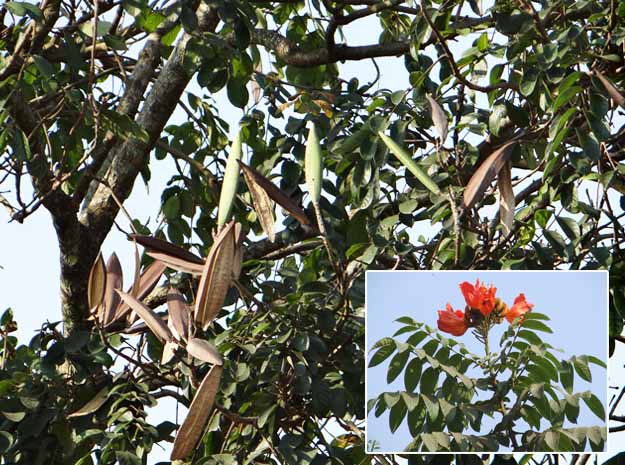
Phaauntan-maram ഫൗണ്ടന്മരം
Genus: Spathodea
Botanical name: Spathodea campanulata
PLANT NAME IN DIFFERENT LANGUAGES
Sanskrit:
Hindi: Rugtoora
English: African tulip tree, Fountaintree
Malayalam: Phaauntanmaram, Sphaathhoodiya ( ഫൗണ്ടന്മരം, സ്കൂട്ട്മരം )
MEDICINAL PROPERTIES
Phaauntanmaram is a robust tree, growing to a height of 20 meters, with a dense, dark, shining, green crown. Leaves are pinnately compound, 20 to 25 centimeters long, divided into 5 to 8 pairs of leaflets. Leaflets are elliptic-oblong, 7.5 to 11 centimeters long, and 3.5 to 7 centimeters wide, with a pointed tip, and several glands along the midrib near the base. Flower bud is ampule-shaped and contains water. Flowers are large, bell-shaped, up to 10 centimetres long and 5 centimeters wide, borne in terminal, erect inflorescences (racemes), with a peculiar smell. Calyx is spathe-like, strongly curved, brownish, velvety-smooth, and split nearly to the base on one side. Corolla is curved, the tube being narrow below, but strongly inflated and 5-lobed above, scarlet or crimson red, with yellow, frilled edges. Pods are firm, thick, dark-brown, and 15 to 20 centimetres long. Seed is about 2.5 centimetres wide, with a broad, silvery white, transparent wing.
The bark is pulverized and used as a dressing for ulcers and other skin troubles; the fresh inner bark is also applied and a decoction of the bark and leaves is used as a lotion. In senegal bruised leaves and flowers are applied to ulcers. A decoction of the bark is given for the treatment of dysentery and gastrointestinal and kidney trouble. An infusion of the leaves is used for urethral inflammation.
